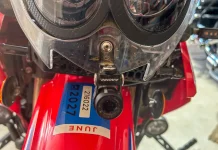Ducati 848 EVO
Ducati motorcycles are quintessentially Italian. They are hot-blooded, good-looking, and they simply ooze charisma. Forever intertwined with racing, Ducati won the very first World Superbike Championship in 1988 and have subsequently dominated it so completely that at one point people started referring to it as The Ducati Cup.
Although a pure racing series, World Superbike is production-machine based, and the superbikes used to such great effect on the track are also available-and only mildly diluted-in your local showroom.
Ducati’s new middleweight Superbike 848 EVO is a strikingly similar motorcycle to its celebrated 1198 sibling and, other than lacking Ducati’s excellent traction control, the only significant difference is the reduced engine displacement.
However, do not let being the smaller brother fool you into thinking that you would be short-changed owning a Ducati 848, because with 140 horsepower and 72 ft/lbs of torque on tap, the 848 can get around in as big of a hurry as you want.
One word of caution though – those attractive-looking mirrors on the Ducati 848 EVO are functionally all but useless unless you like to admire your own arms. Checking for flashing lights behind you requires an elbows-up Ben Spies riding style and a cockeyed squint under your armpit. Ducati sells a 30mm mirror-extension kit, and I would heartily recommend fitting that unless you recently saved an officer’s life and have video proof.
Clichéd as it may be, racing does indeed improve the breed, and the 848 is a prime example. Having seen some serious AMA competition this past year, a few tweaks based directly on input from the racers has given us the EVO edition. New cylinder heads with revised porting and an increased compression ratio, redesigned pistons, hotter camshafts, and much larger elliptical throttle bodies, all contribute to boosting the EVO’s output some six horsepower above the 848 S it replaces.
Six horses may not sound like a huge improvement, but the 848’s engine now revs harder and spools up more quickly, and that translates to an urgency in the motor that seems hard-wired straight back to the rider. The gearing is tall (80 mph in 5th gear-with one still to go-equals only 4000 rpm), but the engine is more than torquey enough to handle it if you want to ride the 848 lazily. Normal riding conditions typically use 3rd and 4th gear; 6th gear is an overdrive that will either get you a Bonneville Salt Flats record-or arrested, if you’re on the street.
The power delivery of the 848’s L-twin Testastretta engine is such that if you find some open road and really let it rip, the acceleration borders on savage. With a power-to-weight ratio that is better than Ducati’s own 999 of just a few years ago, the EVO simply roars Superbike. The gas tank fills up after only around three gallons are pumped in, so if you’re into distance riding you will be irritated by the frequent fuel stops; but the EVO’s riding position is so uncompromising, opportunities to stop and catch your breath aren’t necessarily unwelcome.
A big change for the EVO is the brake upgrade to a top-of-the-line Brembo Monobloc radial system. Ducati has clearly reworked the pressure ratios, because the overly sharp initial bite of previous radial systems has been subtly reduced. It’s not that the previous model’s brakes were bad, but the 848 now has a spectacularly powerful front brake with plenty of feel at the lever. Excellent braking is especially important, as the 848 EVO lacks a slipper clutch.
The chassis is Ducati’s signature trellis frame suspended on 43mm Showa forks at the front and a fully adjustable Showa shock at the rear. A non-adjustable cross-mounted steering damper has been added, and it is surprisingly useful for bumpy roads. All up, the claimed dry weight of the 848 EVO is a mere 370 pounds.
Feel – especially at the front end of a motorcycle – is a somewhat nebulous thing and difficult to quantify. Much has been made recently of the lack of it at the front-end of Ducati’s MotoGP race machine. Confidence in the front is vital when riding on the road, especially given the propensity for corners to gather unexpected slippery substances ready to slide you into the scenery. The 848 EVO suffers no front-end problems and steers precisely and confidently. Corner entries can be taken with real commitment; the 848 EVO turns easily and goes to maximum lean angle quickly, but without flopping in or oversteering into the bend.
The downside of this excellent, neutral handling is of course firm suspension, and a couple of times over bigger bumps I found myself bounced off the hard race-type seat. But the EVO is so together, so well evolved, that you can philosophically shrug your shoulders and carry on barreling down the road completely unfazed.
The clocks are an enhancement from the racetrack, too, and the single MotoGP-style pod has an LCD readout that contains all the information you could possibly need. However, the thin black digits on a gray background are pretty tough to read in daylight unless I have my reading glasses on. The panel is backlit in white, so, ironically, in low-light conditions the readout is much easier to decipher.
At the end of the day, I am prepared to forgive the Ducati’s minor quirks, simply because the caliber and charisma of this machine is simply stratospheric. The bark from the twin underseat exhausts, the low-frequency vibrations, and clattering from the desmodromic valve train give the bike a raw, mechanicalness that makes it feel alive. The Ducati 848 EVO is a breathtakingly single-purpose, physical type of ride-and it requires the commitment of Spartacus to get the best from it. Happily, it rewards that commitment with a precision and clarity at high-speed that is truly satisfying.
RIDING STYLE
- Helmet: Arai Corsair-V Randy Red
- Jacket: Dainese Tattoo YKZ
- Gloves: Sidi Power
- Pants: Dainese SF Pelle
- Boots: Sidi Stealth ST
Photography – Don Williams










